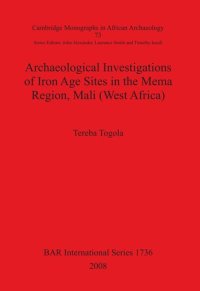
Ebook: Archaeological Investigations of Iron Age Sites in the Mema Region, Mali (West Africa)
Author: Tereba Togola
- Series: BAR British Archaeological Reports International Series 1736
- Year: 2008
- Publisher: BAR Publishing
- Language: English
- pdf
The region traditionally known as the Méma is a plain of deep alluvial deposits that lies west of the current seasonally flooded Inland Delta of the Niger River and southwest of the Lakes Region. The Méma is also sometimes referred to in the literature as the 'Dead Delta', a name that evokes the presence of a dense network of dry watercourses. This indicates that the Méma once formed a floodplain of pseudo-deltaic hydrology similar to that of the current active floodplain to the southeast. Today, the Méma lies within the sahelian zone and is very dry. The spotty distribution of modern permanent settlement in the Méma contrasts sharply with the situation during the last millennium. The fieldwork presented in this volume has identified numerous Iron Age (IA) habitation mounds. This thriving human settlement, clearly associated with a period of climatic amelioration, extends back in time to the Late Stone Age (LSA). Due to the dearth of information on both the history and archaeology of Méma, the Méma archaeological research program was designed as an exploratory inquiry. The primary objective of the archaeological research program executed from December 1989 to June 1990 was to collect basic data that will permit a preliminary analysis of settlement pattern and radiocarbon and ceramic chronology as well as a careful description of the material culture of the Méma during the Iron Age (IA). Research comprised two components: a) a regional site survey and b) the excavations at the IA site complex of Akumbu. These two components had the broad common goal of collecting basic information from which future research questions and research strategies could be derived.